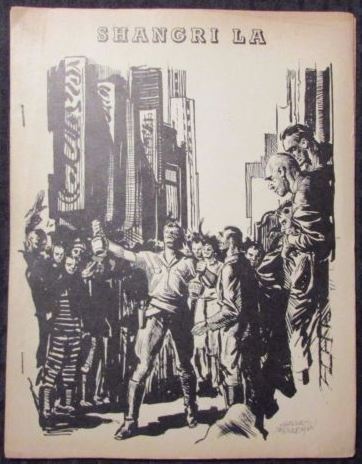Yesterday, we had fun exhuming L. Ron Hubbard’s bad science fiction by looking at a telling 1940 short story, “One Was Stubborn.” In it, Hubbard’s main character, Old Shellback, reveals that the downfall of the United States would come as a result of nefarious religious cults protected by tax exemption. Spooky, right?
Well, continuing with the subject of Hubbard’s fiction, we have been sent a gift by one of our readers. It’s the full original edition of author William Blackbeard’s damning analysis of Hubbard’s work, published just as Dianetics was coming out in May 1950.
Blackbeard’s piece, “Pipsqueak Prometheus: Some Remarks on the Writings of L. Ron Hubbard,” came to our attention last month when we published a document that researcher R.M. Seibert had pried out of the Food and Drug Administration as part of the FDA’s long investigation of Hubbard and Scientology from 1958 to 1971. In 1970, FDA inspectors interviewed science fiction fan and New Jersey resident Sam Moskowitz, who had witnessed Hubbard say at a 1948 science fiction gathering that “the only way to make a million dollars was to form your own religion.”
When the inspectors asked Moskowitz for other sources of information they could turn to about Hubbard, he mentioned that author William Blackbeard had written the harsh takedown about Hubbard’s fiction in 1948. Actually, it appeared in the Los Angeles science fiction fanzine “Shangri La” in 1950. One of our readers managed to get his hands on a copy at eBay, and then sent us scans of “Pipsqueak Prometheus.”
It’s pretty fun. Blackbeard is actually pretty charitable, giving Hubbard credit for writing one really arresting novel, 1940’s Fear. (Harlan Ellison, when we visited him a few years ago, also pointed to Fear as Hubbard’s best work and a novel he holds in high esteem.) But for the most part, Blackbeard writes, Hubbard composes too quickly and too sloppily, relying on the same tired stereotypes over and over. And when Hubbard is called on it, he tries to sidestep criticism by saying his pulp writing is done for money and even he doesn’t take it seriously. That’s a weak dodge, Blackbeard says, especially when it’s clear that Hubbard can produce quality work on occasion. It was also clear that Blackbeard didn’t think much of Dianetics.
Blackbeard opens his essay by saying that he had once seen a photograph of Hubbard wearing a pith helmet in the offices of a New York pulp editor, and it struck him as an essential image of the man, and that Hubbard’s pith helmet had entirely enveloped him.
Hubbard’s faults, Blackbeard says, could be found in his first published work of science fiction, the 1938 short story “The Dangerous Dimension,” which appeared in Astounding Science-Fiction.. “This initial work, brief though it is and hastily written, contains in seedling form nearly every point which I wish to make about Hubbard’s writing, points which later grew to become monstrously evident in most of his major fiction and sent clotting branches into nearly everything else he wrote,” Blackbeard writes.
In the story, there’s an absent-minded scientists named Dr. Henry Mudge who has a fantastic ability that “whisks him about from place to place.” The meek man with miracle powers is a stereotype that shows up time and again in Hubbard’s writing, Blackbeard says. And so do his female characters, a motherly Mrs. Doolin and another woman who, it’s implied, is a prostitute. And not only will these types show up repeatedly, but so does Hubbard’s comic strip ejaculations like “WHOOOoosh!” and “Whup!”
Blackbeard considers the notion that Hubbard falls back on such stereotypes because he’s pretty up front about the idea that he’s not trying very hard for the stuff he sells to the pulps. But Hubbard has shown some quality, even in the pulps, he points out, so it’s a weak excuse.
Getting back to his analysis, Blackbeard states outright that “Hubbard is not a good writer.” His writing is “slovenly, ill-paced (meandering at one point and breaking into a halting gallp at another for no apparent reason), confused, and possesses a tendency to telegraph what little punch it is able to develop.”
Blackbeard wonders if this is partly because Hubbard tries to put together disparate styles, mashing up Dickens with contemporary pulp, for example. He points to a particular passage, which has a scientists sitting at his desk pondering problems with a quill pen in his hand, and sitting at a “rickety desk” like he was Bob Cratchit.
“This incomprehensible gibberish is typical of much that passes for writing in Hubbard’s works; there are worse passages (particularly in Dianetics),” Blackbeard writes. And he has a theory for what motivates Hubbard to put out such “gibberish.” Blackbeard proposes that Hubbard has a “subconscious desire to create a work of genuine and lasting artistic or practical worth, of which he is subconsciously convinced he is incapable,” he writes. “This has led to his ‘exploring,’ to his ‘studies’ in hypnotism, to his postulation of Dianetic ‘therapy,’ to his insufferable ego (see the introduction to the book edition of Final Blackout, for a prime example of this), to his Major Hoople references to past achievements of a largely fictitious nature (see the article by Hubbard, written under a pseudonym, in Air Trails for April, 1949, in which he makes praising reference to his considerable research work in the aeronautical field under discussion — which he most certainly never undertook in any extensive degree), and to each and all of those aspects of the Hubbard nature which have astounded, shocked, and puzzled his acquaintances — Hubbard probably is incapable of true friendship or love for anyone other than himself, excepting a sort of eager dependence, concealed in snobbish condescension, he probably feels toward those who see him in his own terms and treat him accordingly — for so many years.”
It’s like the man is able to read Hubbard’s mind, isn’t it? Truly a remarkable assessment, and one that seems spot-on.
Bill Blackbeard died in Watsonville, California in 2011 at 84. He is remembered as “the man who saved the comics,” and we found a fascinating remembrance of him here.
——————–
Bonus photos from our tipsters
Actual caption: “The Final 40 recruitment game (the final 40 staff needed to go Double Saint Hill Size by March 13th) has launched!!! #39 just joined the ranks… Very well done and welcome aboard to Anna Sotomayor!!” Tampa, “Double Saint Hill Size.” Oh, the delusion, it burns.
Hey, girl. Let’s survive the Denver winter together.
Hey, girl. I’ve just completed my hatting at the Hubbard College of Administration in Los Angeles.
——————–
 Posted by Tony Ortega on February 16, 2016 at 07:00
Posted by Tony Ortega on February 16, 2016 at 07:00
E-mail tips and story ideas to tonyo94 AT gmail DOT com or follow us on Twitter. We post behind-the-scenes updates at our Facebook author page. After every new story we send out an alert to our e-mail list and our FB page.
Our book, The Unbreakable Miss Lovely: How the Church of Scientology tried to destroy Paulette Cooper, is on sale at Amazon in paperback and Kindle editions. We’ve posted photographs of Paulette and scenes from her life at a separate location. Reader Sookie put together a complete index. More information about the book, and our 2015 book tour, can also be found at the book’s dedicated page.
Learn about Scientology with our numerous series with experts…
BLOGGING DIANETICS: We read Scientology’s founding text cover to cover with the help of L.A. attorney and former church member Vance Woodward
UP THE BRIDGE: Claire Headley and Bruce Hines train us as Scientologists
GETTING OUR ETHICS IN: Jefferson Hawkins explains Scientology’s system of justice
SCIENTOLOGY MYTHBUSTING: Historian Jon Atack discusses key Scientology concepts
Other links: Shelly Miscavige, ten years gone | The Lisa McPherson story told in real time | The Cathriona White stories | The Leah Remini ‘Knowledge Reports’ | Hear audio of a Scientology excommunication | Scientology’s little day care of horrors | Whatever happened to Steve Fishman? | Felony charges for Scientology’s drug rehab scam | Why Scientology digs bomb-proof vaults in the desert | PZ Myers reads L. Ron Hubbard’s “A History of Man” | Scientology’s Master Spies | Scientology’s Private Dancer | The mystery of the richest Scientologist and his wayward sons | Scientology’s shocking mistreatment of the mentally ill | Scientology boasts about assistance from Google | The Underground Bunker’s Official Theme Song | The Underground Bunker FAQ
Our Guide to Alex Gibney’s film ‘Going Clear,’ and our pages about its principal figures…
Jason Beghe | Tom DeVocht | Sara Goldberg | Paul Haggis | Mark “Marty” Rathbun | Mike Rinder | Spanky Taylor | Hana Whitfield











